|
|
| |
|
 | Search: |
|
|
 |

|
|
Accel 2 click carries ST's LIS3DSH IC, a low-power factory-calibrated three-axis accelerometer which embeds a FIFO buffer and two programmable state machines. It allows you to implement gesture recognition. User-defined programs can distinguish movement patterns like shake and double shake, face up and face down, turn and double turn, and activate an interrupt upon their execution. You can also switch between I2C and SPI interfaces for communicating with the target board MCU (by soldering the onboard jumpers in the appropriate positions). Accel 2 click is designed to use a 3.3V power supply only. |
|
|
|
|
 |
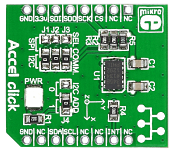
|
|
Accel Click is an accessory board in the mikroBUS form factor. It features the ADXL345 3-axis accelerometer module with ultra-low power and high resolution (13-bit) measurement. Module supports several sensing functions such as single/double tap detection, activity/inactivity monitoring, free-fall detection etc. It has a memory management system with a 32-level FIFO buffer to store data with minimized host processor activity. The board is designed to use 3.3V power supply only. |
|
|
|
 |

|
|
The Three-Axis Accelerometer Board includes a small, thin, low-power, 3-axis accelerometer ADXL330 with signal conditioned voltage outputs. It measures acceleration with a minimum full-scale range of ±3 g. It comes with many ready-to-use examples. |
|
|
|
 |
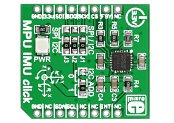
|
|
MPU IMU click carries the MPU-6000 integrated 6-axis motion tracking device, which combines a 3-axis gyroscope, 3-axis accelerometer, and a DMT (Digital Motion Processor) into a single small chip. The gyroscope has a sensitivity up to 131 LSBs and a full-scale range of ±250, ±500, ±1000, and ±2000dps. The accelerometer has a programmable full scale range of ±2g, ±4g, ±8g and ±16g. It communicates with the target board through SPI, I2C, RST and INT lines. The board is designed to use a 3.3V power supply only. An LED diode serves as a power indicator. |
|
|
|
 |
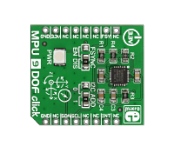
|
|
MPU 9DOF click carries the MPU-9150 System in Package, which is the world's first 9-axis Motion Tracking device. MPU-9150 comprises two chips. One is the MPU-6050 that contains a 3-axis accelerometer, a 3-axis gyroscope, and a DMP (digital motion processor); the other is AK8975, a 3-axis digital compass. The MPU-9150 is designed for the low power, low cost, and high performance requirements of consumer electronics equipment and wearable sensors. The ability to track motion in free space also makes MPU 9DOF click a suitable sensor for RC vehicle (e.g. quadcopters) and camera stabilisation systems. |
|
|
|
 |
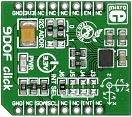
|
|
9DOF click carries ST's LSM9DS1 inertial measurement module that combines a 3D accelerometer, a 3D gyroscope and a 3D magnetometer into a single device outputting so called nine degrees of freedom data (3-axis acceleration, angular velocity and heading), in 16-bit resolution. 9DOF click communicates with the target MCU through the mikroBUS I2C interface (SCL and SDA) with additional functionality provided by the programmable Interrupt (INT) pin, as well as the Enable (EN) pin. The IC has multiple interrupt lines which can be accessed through jumpers on the click board. I2C addresses are specified in the same manner. The board uses a 3.3 power supply only. |
|
|
|
 |
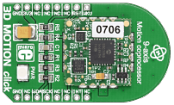
|
|
3D Motion click carries Microchip’s MM7150 9-axis sensor fusion motion module. It's a complete self contained solution comprising a 3-axis accelerometer, a gyroscope, a magnetometer, and a SSC7150 motion coprocessor. The motion coprocessor has sensor fusion alghoritms that take raw data from individual sensors and filter, compensate and combine them together. The resulting output provides reliable and accurate positioning and orientation information. The board communicates with the target MCU through the mikroBUS I2C interface; WAKE and RESET pins are also used (in placed of default mikroBUS AN and RST respectively), as well as an interrupt pin (INT). |
|
|
|
 |
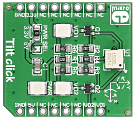
|
|
Tilt click carries a RPI-1035, 4-directional optical tilt sensor. This type of sensor provides positional feedback for left, right, backward or forward movement (tilt). Compared to mechanical solutions, optical direction detectors are less prone to noise caused by vibrations. Compared to magnetic-based direction detectors, they are not influenced by magnetic disturbances. Tilt click communicates with the target board microcontroller through mikroBUS PWM and INT lines, used here for vout1 and vout2 outputs from the sensor. In addition, two onboard LEDs provide visual feedback from the sensor. The board is designed to use either a 3.3V or 5V power supply. |
|
|
|
 |
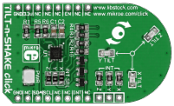
|
|
TILT-n-SHAKE click carries Freescale’s MMA8491Q IC. It's a multifunctional 3-axis digital accelerometer that can also be configured as a 45-degree Tilt sensor. To use it as an accelerometer, keep the EN pin pulled to logic level high. The acceleration data will be outputted to the target MCU through mikroBUS I2C pins (SCL, SDA). The output time is about 700 microseconds, with a 14-bit resolution, ±8 full-scale range and 1 mg/LSB sensitivity. As a Tilt sensor, the click board needs only one output pin — INT (interrupt). Three onboard LEDs will also signal the tilt orientation. TILT-n-SHAKE click is designed to use a 3.3V power supply only. |
|
|
|
 |
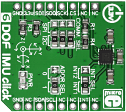
|
|
6DOF IMU click is a mikroBUS add-on board that carries ST's LSM6D33 IC, which is 6-axis inertial measurement unit comprising a 3-axis gyroscope and a 3-axis accelerometer. The chip is a highly accurate 6 DOF inertial measurement unit with long-term stable operation over a wide range of temperatures. It's high robustness to mechanical shock makes is suitable for designing reliable platform stabilization systems, for example in cameras and drones. The board communicates with the target MCU either through I2C or SPI interfaces (along with an additional INT pin). |
|
|
|
 |

|
|
Vibra Sense click is a low cost micro shock vibration sensor with a digital output which can be set as an Interrupt (mikroBUS INT pin) An onboard potentiometer lets you set the interrupt threshold. An additional Enable line (EN) is in place of the mikroBUS pin. It's a very simple and effective solution for detecting vibrations. The sensing unit consists of a round housing in which a spring is coiled around a metal pin. When exposed to vibration, the spring contacts the pin and closes the switch. The board is designed to use either a 3.3V and a 5V power supply. |
|
|
|
 |

|
|
Shake2Wake click carries an ADXL362 ultralow power, 3-axis MEMS accelerometer from Analog Devices. The distinguishing feature of this IC is that it incorporates several activity detection modes. The interrupt pins from the chip are connected to an onboard ADP195 power switch IC that in turn controls an external device connected through a screw terminal. The detection threshold is configurable (both intensity and duration). The duration of inactivity that leads to switching off is also programmable. Shake2Wake click can also be used as a regular accelerometer, for continuous sensing, in which case it communicates with the target MCU through mikroBUS SPI interface. Uses 3.3V power supply only. |
|
|
|
 |

|
|
Accel 3 click is a mikroBUS add-on board with ST's H3LIS331DL low-power high-g 3-axis digital accelerometer. The IC has ±100g/±200g/±400g dynamically selectable full scales and outputs 16-bit data at rates from 0.5 Hz to 1 kHz. On the upper end, the chip can survive a 1000g high-shock. H3LIS331DL has extremely low power consumption (down to 1 micro amp in low-power mode). Advanced sleep-to-wakeup functions are also available. Accel 3 click can communicate with the target MCU either through the mikroBUS SPI or UART interface, with additional functionality provided by an interrupt pin (INT). The board is designed to use a 3.3 power supply only. |
|
|
|
 |
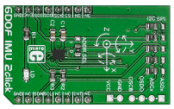
|
|
6DOF IMU 2 click is a mikroBUS™ add-on board with Bosch's BMI160 low power inertial measurement unit (IMU). The BMI160 is capable of precise acceleration and angular rate (gyroscopic) measurement.
The IMU consists of a state-of-the-art 3-axis, low-g accelerometer, and a low-power 3-axis gyroscope, designed for 6-axis and 9-axis applications. The BTI160 also includes built-in power management unit (PMU) for advanced power management and power-saving modes, as well as allocated FIFO buffer of 1024 bytes for handling external sensor data.
6DOF IMU 2 click communicates with the target MCU through the I2C or SPI bus (user-selectable), with additional functionality provided by the INT pin (for enhanced autonomous motion detection).
The board is designed to use a 3.3 power supply only. |
|
|
|
 |
|
|

